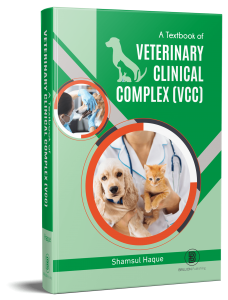Today’s veterinarians are the only doctors educated to protect the health of both animals and people. Veterinarians also play critical roles in environmental protection, research, food safety, and public health. Veterinarians are the first and best line of defense against animal diseases that could threaten public health and our national security.What makes a veterinary practice a success? The Veterinary TEAM is the answer. The contents of the present text book of VCC have been divided into 87 chapters under six sections based on modified syllabus of VCI covering basics of veterinary clinical complex(VCC). The clinical examination is a search for clues in an attempt to solve the mystery of a patient’s illness. These clues are found usually in the form of “signs” that are demonstrated to the clinicians through inspection, palpation, percussion, and auscultation. The focal point of any investigation of animal disease is the making of a diagnosis.
Features
Each chapter opens with a “Day in the Life”.
More attention in this textbook of VCC has been granted to diagnose animal’s diseases through advanced diagnostic techniques using modern relevant lab instruments like hematoanalyser, automatic biochemical analyzer, electrolytes analyzer and the correct interpretation of lab results.
In this text book it has also been emphasized that how the advanced diagnostic equipments like ECG machine, ultrasonographer will be used and how the findings will be interpreted to diagnose the animal’s diseases perfectly.
Throughout the text it has been tried that UG students could keep themselves updated with new dimensions of veterinary clinical complex like hemodylysis of kidney failure case in dogs and blood transfusion in animals.
The author covered crucial topics such as critical care, Receptors, Antibodies and immunity because in the current scenario every UG student of veterinary clinical subjects try to know on which receptor the particular prescribed drug will be acting and whether it has relevancy with the diagnosed disease or not.
Emphasis has been given to, how the emergency patients will be treated and managed in ICU.
This textbook book will explores the potential capability of VCC students in the field of disease diagnosis, treatment and management.
As such, this textbook of VCC offers a valuable resource of clinical potency to veterinary students, academicians and veterinarians.
Orientation, Registration and General Introduction
Methods used in the Detection of Clinical Signs
Preliminary Clinical Examination
Techniques used in Clinical Examination
Restraint: Handling and Restraining of Animals
Important Information about Horses
Examination of Lymphatic System in Horses
Equine Stay Apparatus (Sleep in Standing Position)
Handling and Restraint of Dogs and Cats
First Aid
Preparation and Sterilization of Surgical Packs,
Instruments, Drapes and Operation Theaters for Surgical
Intervention
Waste Disposal in Clinical Procedures
Antiseptic Dressing Techniques and Bandaging
Holistic or Herd Health Management
Complete Blood Count (CBC)
Lab Techniques
Evaluation of Acid-base Balance, Interpetation of
Laboratory Test Results in Respect of Hematological and
Biochemical Parameters in Different Diseases
Summary of Bone Marrow Smear Evaluation Procedure
Enzymes Related to Cardiac Diseases and Cardiac Markers
An Enzyme-linked Immunosorbent Assay (ELISA)
Staining for Bacterial Examinations
Fecal Examinations
Mange and its Examination
Laboratory and Special Examination
Samples for Serologic Tests
Guidelines for Selection and Submission of Necropsy
Specimens for Conrmation of Diagnosis
Field Laboratory Methods
Handling of Specimens
Collection of Blood in Large and Small Animals for
Bacteriological, Viral, Parasitological and Molecular Tests
Quantitation Techniques
Neutropenia (Low Neutrophil Count)
Monocytopenia (Low Monocyte Count)
Thrombocytopenia (Low Platelet Count)
Blood Differential Cell Test
Anemia
Molecular Biology
Techniques in Molecular Biology
Principles of Ultrasonography
Abdominal Ultrasonography in the Equine with Acute Signs of Colic
Small Animal (Dogs and Cats) Abdominal Ultrasonography
An Antibody (Ab)
Receptors
Immunity
Emergency Medicine and Critical Care
Initial Assessment and Care on Arrival for Critical Care
Obtundation
Special Considerations for the Hospitalized Patient
Critical Care
and so on…


